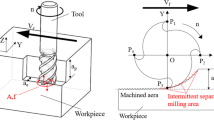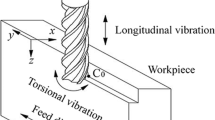Abstract
To study the effect of different parameters on milling force for longitudinal-torsional ultrasonic vibration milling (LTUM) of titanium alloy, the kinematic theory of LTUM is combined with the model of milling transient cutting thickness to establish the milling force equation, and experiment was carried out. The experimental results showed that milling force was positively correlated with cutting speed, cutting depth, feed per tooth (milling force increased by about 40% in increasing the cutting speed from 40 to 100 m/min, 300% in increasing the depth of cut from 0.1 to 0.4 mm, and 25% in increasing the feed per tooth from 0.01 to 0.04 mm). Milling force was negatively correlated with ultrasonic amplitude, tool helix angle (milling force reduced by about 22% in increasing the ultrasonic amplitude from 1 to 4 μm, and 23% in increasing the tool helix angle from 30 to 45°). The milling force was minimized when the ultrasonic amplitude was 4 μm; cutting speed was 60 m/min; cutting depth was 0.1 mm; feed per tooth was 0.01 mm/z, and tool helix angle was 40°. Furthermore, the empirical model of milling force was established, and accuracy was verified by experimental data.








Similar content being viewed by others
Data availability
Not applicable.
Code availability
Not applicable.
References
Zhao B, Li P, Zhang C, Wang X (2020) Effect of ultrasonic vibration direction on milling characteristics of TC4 titanium alloy. Acta Aeronautica et Astronautica Sinica 41:39–49. https://doi.org/10.7527/S1000-6893.2019.23301
Cui C, Hu BM, Zhao L, Liu S (2011) Titanium alloy production technology, market prospects and industry development. Mater Des 32:1684–1691. https://doi.org/10.1016/j.matdes.2010.09.011
Shen X, Xu G (2018) Study of milling force variation in ultrasonic vibration-assisted end milling. Mater Manuf Processes 33:644–650. https://doi.org/10.1080/10426914.2017.1364846
Zhang X, Zhang J, Zhou H, Ren Y, Xu M (2018) A novel milling force model based on the influence of to ol geometric parameters in end milling. Adv Mech Eng 10:2072048906. https://doi.org/10.1177/1687814018798185
Li Y, Yang ZJ, Chen C, Song YX, Zhang JJ, Du DW (2018) An integral algorithm for instantaneous uncut chip- thickness measuring in the milling process. Adv Prod Eng Manag 13:297–306. https://doi.org/10.14743/apem2018.3.291
Zhu K, Zhang Y (2017) Modeling of the instantaneous milling force per tooth with tool run-out effect in high speed ball-end milling. Int J Mach Tools Manuf 118–119:37–48. https://doi.org/10.1016/j.ijmachtools.2017.04.001
Zhu K, Li G (2021) Theoretical modeling and experimental study of micro milling force based on tool wear mapping. J Mech Eng 57:246–259. https://doi.org/10.3901/JME.2021.19.246
Kim GM, Cho PJ, Chu CN (2000) Cutting force prediction of sculptured surface ball-end milling using Z-map. Int J Mach Tools Manuf 40:277–291. https://doi.org/10.1016/S0890-6955(99)00040-1
Kim GM, Chong NC (2004) Mean cutting force prediction in ball-end milling using force map method. J Mater Process Tech 146:303–310. https://doi.org/10.1016/j.jmatprotec.2003.11.021
Chen Q, Dai L, Liu Y, Shi Q (2020) A cortical bone milling force model based on orthogonal cutting distribution method. Adv Manuf 8:204–215. https://doi.org/10.1007/s40436-020-00300-7
Shan C, Wang X, Yang X, Xiaobo L. (2016) Prediction of cutting forces in ball-end milling of 2.5D C/C composites. Chin J Aeronaut,7. https://doi.org/10.1016/j.cja.2015.12.015
Jiang X, Kong X, He S, Wu K (2021) Modeling the superposition of residual stresses induced by cutting force and heat during the milling of thin-walled parts. J Manuf Process 68:356–370. https://doi.org/10.1016/j.jmapro.2021.05.048
Li Z, Zhu L, Yang Z, Ma J, Cao W (2022) Investigation of tool-workpiece contact rate and milling force in elliptical ultrasonic vibration-assisted milling. Int J Adv Manuf Technol 118:585–601. https://doi.org/10.1007/s00170-021-07946-y
Lotfi M, Akbari J (2021) Finite element simulation of ultrasonic-assisted machining: a review. Int J Adv Manuf Technol 116:2777–2796. https://doi.org/10.1007/s00170-021-07205-0
Ni C, Zhu L, Ning J, Yang Z, Liu C (2019) Research on the characteristics of cutting force signal and chip in ultrasonic vibration-assisted milling of titanium alloys. J Mech Eng 55:207–216. https://doi.org/10.3901/JME.2019.07.207
Niu Y, Jiao F, Zhao B, Gao G. (2019) Investigation of cutting force in longitudinal-torsional ultrasonic-assisted milling of Ti-6Al-4V. Materials (Basel),12. https://doi.org/10.3390/ma12121955
Tao G, Ma C, Shen X, Zhang J (2017) Experimental and modeling study on cutting forces of feed direction ultrasonic vibration-assisted milling. Int J Adv Manuf Technol 90:709–715. https://doi.org/10.1007/s00170-016-9421-7
Abootorabi Zarchi MM, Razfar MR, Abdullah A (2012) Investigation of the effect of cutting speed and vibration amplitude on cutting forces in ultrasonic-assisted milling. Proc IME B J Eng Manufact 226:1185–1191. https://doi.org/10.1177/0954405412439666
Verma GC, Pandey PM, Dixit US (2018) Modeling of static machining force in axial ultrasonic-vibration assisted milling considering acoustic softening. Int J Mech Sci,136. https://doi.org/10.1016/j.ijmecsci.2017.11.048
Gao G, Hu E, Xiang D, Zhao B (2018) Theoretical modeling of the milling force of C / C composites in ultrasonic milling. J Vib Shock 37:8–13. https://doi.org/10.13465/j.cnki.jvs.2018.10.002
Niu Y, Jiao F, Zhao B, Tong J (2019) Experiment of machining induced residual stress in longitudinal torsional ultrasonic assisted milling of Ti-6AI-4V. Surf Technol 48:41–51. https://doi.org/10.16490/j.cnki.issn.1001-3660.2019.10.005
Niu Y, Jiao F, Zhao B, Wang X (2019) 3D Finite element simulation and experimentation of residual stress in longitudinal torsional ultrasonic assisted milling. J Mech Eng 55:224–232. https://doi.org/10.3901/JME.2019.13.224
Zhu L, Zhu C, Pei J, Li X, Wei W (2014) Prediction of three-dimensional milling forces based on finite element. Adv Mater Sci Eng 2014:1–7. https://doi.org/10.1155/2014/918906
Yang Y, Wan M, Feng J et al (2017) Working mechanism of helix angle on peak cutting forces together with its design theory for peripheral milling tools. J Mater Process Technol. https://doi.org/10.1016/j.jmatprotec.2017.06.030
Wang X (2018) SiCp/AL Milling mechanism and surface quality under ultrasonic excitation. Doctor North University of China
Wang BS, Zuo JM, Wang ML, Hou JM (2012) Prediction of milling force based on numerical simulation of oblique cutting. Mater Manuf Processes 27:1011–1016. https://doi.org/10.1080/10426914.2011.654150
Kline WA, Devor RE, Lindberg JR (1982) The prediction of cutting forces in end milling with application to cornering cuts. Int J Mach Tool Des Res 22:7–22. https://doi.org/10.1016/0020-7357(82)90016-6
Budak E, Altintas Y, Armarego E (1996) Prediction of milling force coefficients from orthogonal cutting data. J Manuf Sci Eng 118:216–224. https://doi.org/10.1115/1.2831014
Altintas Y (2012) Manufacturing automation : metal cutting mechanics, machine tool vibrations, and CNC design / 2nd. Manufacturing automation : metal cutting mechanics, machine tool vibrations, and CNC design / 2nd.13–15
Shang P, Huang S, Liu X, Yang Z, Liu T, Zhang J (2021) Modeling and experimental study on cutting forces of 2D vibration assisted micro-milling. China Mech Eng 32:648–657. https://doi.org/10.3969/j.issn.1004-132X.2021.06.003
Funding
This research is supported by The National Natural Science Foundation of China project “Research on subsurface damage mechanism of ceramic matrix composites machined by high speed multi-dimensional ultrasonic” (Project code: 52005164).
Author information
Authors and Affiliations
Contributions
All related authors contributed to the conceptualization, data curation, investigation, methodology, writing—original draft, writing—review, and editing of the manuscript.
Corresponding author
Ethics declarations
Ethics approval
This paper is new. Neither the entire paper nor any part of its content has been published or has been accepted elsewhere. It is not being submitted to any other journal as well.
Consent to participate
Not applicable.
Consent for publication
Not applicable.
Conflict of interest
The authors declare no competing interests.
Additional information
Publisher's note
Springer Nature remains neutral with regard to jurisdictional claims in published maps and institutional affiliations.
Rights and permissions
Springer Nature or its licensor (e.g. a society or other partner) holds exclusive rights to this article under a publishing agreement with the author(s) or other rightsholder(s); author self-archiving of the accepted manuscript version of this article is solely governed by the terms of such publishing agreement and applicable law.
About this article
Cite this article
Zhao, M., Zhu, J., Song, S. et al. Influence of machining parameters in longitudinal-torsional ultrasonic vibration milling titanium alloy for milling force. Int J Adv Manuf Technol 123, 3587–3597 (2022). https://doi.org/10.1007/s00170-022-10509-4
Received:
Accepted:
Published:
Issue Date:
DOI: https://doi.org/10.1007/s00170-022-10509-4




